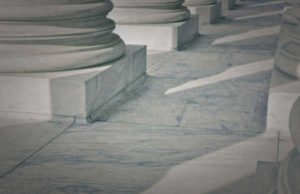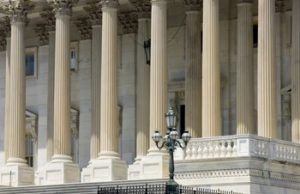
Supreme Court Justice: William Howard Taft
William Howard Taft was the 27th President of the United States and later the 10th Chief Justice of Supreme Court from 1921 to 1930. He is the only individual to have served in both of these positions, and one of only two presidents to have also headed a different branch of the federal government, excluding vice-presidents who later went on to become president.
William Howard Taft was born near Cincinnati on September 15, 1857. Taft went to Woodward High School in Cincinnati, and then continued on to attend Yale College in New Haven, Connecticut, where he was a member of the Beta chapter of Psi Upsilon, Linonian Society, and Skull and Bones. William Howard Taft graduated second in his class in 1878 and continued his education at Cincinnati Law School, where he received a Bachelor of Laws in 1880.
On June 30, 1921, President Warren G. Harding nominated William Howard Taft for the seat of Chief Justice of the United States Supreme Court. The Senate approved Taft with a 60-4 vote in a secret session on the same day of the nomination, and Taft immediate received his commission. He took the oath of office on July 11, 1921, and served the court until retirement in 1930 due to his failing health.
William Howard Taft decided to promote the introduction and passage of the 1925 Judiciary Act, which shifts the appellate jurisdiction of the Supreme Court to be mostly discretionary upon reviewing litigants’ petitioning , allowing the Supreme Court to preferentially receive cases that they believed were of national importance, allowing the Court to work in a more efficient manner.
Famous Cases
Balzac v. Porto Rico (1922): A Supreme Court case where the court held that some provisions of the United States Constitution were not applicable to territories which were not incorporated into the union. This case began when Jesús M. Balzac was prosecuted for a criminal libel in Puerto Rico’s district court. He declared that his Constitutional rights had been violated under the Sixth Amendment since he was denied a trial by jury. He had not been given a trial by jury because the Puerto Rico’s code of criminal procedure did not allow for a jury trial for cases regarding misdemeanor. In the court appeal, the United States Supreme Court affirmed the judgments made by the lower courts in Puerto Rico in deciding that the relevant Constitutional provisions did not apply to a territory that was not incorporated into the Union, while belonging to the United States.
The Supreme Court held a unanimous opinion which was delivered by Chief Justice William Howard Taft. Chief Justice Taft argued that while the Jones Act had granted citizenship to the people of Puerto Rico, the act had not actually incorporated Puerto Rico into the Union. Although the island had been under the United States control since after the 1898 Spanish-American War, the territory had never been designated for any sort of ultimate statehood. Chief Justice William Howard Taft distinguished Puerto Rico from the territory received in the Alaska purchase, which was acquired in 1867 from Russia, that in Rasmussen v. United States had been held to be incorporated. Thus, specific constitutional provisions were given based on location, instead of on citizenship.
Chief Justice William Howard Taft reason for denying jury trial was very similar to earlier reasoning in older Insular Cases. Chief Justice Taft argued that since Puerto Rico had been previously governed by Spanish civil law for four hundred, the inhabitants would not be prepared for jury service. Chief Justice Taft also argued that the locals should have the ability to determine their own laws. In the opinion, the court failed to resolve the exact fundamental personal rights that would be extended to American citizens in Puerto Rico.
Bailey v. Drexel Furniture Co. (1922): A Supreme Court case in which the court ruled that the Child Labor Tax Law of 1919 was unconstitutional and an inappropriate attempt by the United States Congress to penalize employers who used child labor. The Supreme Court indicated that the tax law imposed by the statute was not really a tax but really a penalty in disguise.
Congress passed the Child Labor Tax Law on February 24, 1919, which created an excise tax of 10% on the net profits generated by a company that used children as employee. The tax law defined child labor as a worker under the age of 16 in a mine or quarry, and under the age of 14 in a cannery, mill, workshop, manufacturing, or factory establishment. The definition of child labor also included using children between the ages of 14 and 16 who worked over 8 hours a day or over 6 days a week, or worked between 7PM and 6AM. Drexel Furniture Co. was a furniture manufacturing company based in North Carolina.
On September 21, 1921, a Bureau of Internal Revenue collector assessed $6,312.79 in excise taxes from the company for employing a child under the age of 14 during the 1919 tax year. The company paid the tax under protest, and then sued for a refund after. The main argument used by Drexel was that the tax was an attempt to regulate manufacturing in an unconstitutional manner. The U.S. argued that the statute did not need to meet any standard if it was a geographically uniform indirect tax. Additionally, the United States said that the tax was only an excise tax levied by the United States Congress under the broad power of taxation found in Article One of the U.S. Constitution. The lower court ended up ruling in favor of the company.
Chief Justice William Howard Taft’s Court declared that the tax placed on child labor was unconstitutional since it was not actually a tax but rather it was a penalty on the employment of children. Additionally, the Child Labor Tax Law regulated businesses rather than acting as a tax. Chief Justice William Howard Taft argued the law described a specific course for businesses. Under the tax act, any deviation from that court resulted in a payment being enacted.
Chief Justice William Howard Taft also said that the court had to commit itself ultimately to the law of the land, even if it required them to refuse a piece of legislation created to promote the highest good. Chief Justice Taft continued on by saying that good sought in legislation that is unconstitutional leads legislators and citizens down a risky path of compromising the constitution and its standards. Additionally, Congress could then take control of different areas of public interest that are normally controlled by the States under the Tenth Amendment. The Supreme Court later abandoned the philosophy found in the Bailey case.
Adkins v. Children’s Hospital (1923): A Supreme Court case where the opinion held that the federal minimum wage legislation for women was an unconstitutional violation of the liberty of contract, which is protected by the due process clause found in the Fifth Amendment. Congress passed a law setting the minimum wages for children and woman in 1918 in Washington, DC
As in other court cases, the issue of the case balancing the power Congress had to regulate safety and health with the right that individuals had to conduct their own business and affairs without having interference from Congress. Children’s Hospital along with female elevator operator from a hotel brought this court case to prevent enforcement of this minimum wage legislation by Jesse Adkins and the two wage board members.
The Supreme Court opinion held that previous court decisions such as Muller v. Oregon (1908) or Bunting v. Oregon (1917) did not overrule the decision made in Lochner v. New York (1905) which protected the freedom of contract. The Supreme Court argued that if Congress was allowed to set laws regarding minimum wage, they would also be allowed to set wage laws regarding maximum wage. The majority opinion also discussed the changes that had occurred after Muller, particularly the passage of the 19th Amendment, which granted women the right to vote.
The opinion mentions any differences between men and women that justify special protection for women are no longer relevant in respect to the cultural changes that have occurred, particularly in the political, civil, and contractual, status of women, which have culminated in the 19th Amendment. Chief Justice William Howard Taft dissented and argued that there that there was no real different between maximum hour laws and minimum wage laws, considering that both of these effectively become restrictions on the employment contract. Chief Justice William. Adkins v. Children’s Hospital was ultimately overturned 1937 in West Coast Hotel Co. v. Parrish.
Carroll v. United States (1925): A Supreme Court decision that upheld that a search of an automobile without a warrant is the automobile exception. This court case has also been referred to in order to increase the scope of searches without warrants. In the case, federal prohibition officers set up an undercover purchase of liquor from an illicit dealer, George Carroll, who was under investigation, but the purchase transaction had not been completed. Later, the officers saw Carroll driving from Detroit to Grand Rapids on the highway, which they patrolled regularly. The officers gave chase, pulled the car over, and searched it, finding illegal liquor in the car.
The National Prohibition Act Stated that officers had the right to make searches of vehicles, airplanes, or boats without warrants when they had a reason to believe that illegal liquor was being transported. The Supreme Court noted that the U.S. Congress removed the need for a warrant in situations regarding border and that Congress always understood an important difference between searches of buildings versus vehicles for contraband items, where it is not as practical to acquire a warrant, since the vehicle can be moved quickly out of the jurisdiction or locality where the warrant must be acquired.
However, Chief Justice William Howard Taft and the Supreme Court held in a majority opinion that it would be unreasonable and intolerable if a prohibition agent had the authority to stop any vehicle on the chance of finding liquor, subjecting all individuals who are lawfully using the roads to the indignity and inconvenience of the search. The Supreme Court also added that when the securing of a warrant is done reasonably, it must be done.
This precedent became known as the Carroll doctrine, meaning a warrant was necessary to search a vehicle if there was some probable cause to think that evidence was present, coupled with pressing circumstances to think that the vehicle could be removed from the area acquiring a warrant.
Myers v. United States (1926): A United States Supreme Court decision which ruled that the President of the United States can remove executive branch officials with his exclusive powers, and is not required to obtain the approval of the Senate or another legislative body.
Frank Myers, a First-Class Postmaster in Portland, Oregon, was removed from his office by President Wilson in 1920. A federal law created in 1876 stated that first, second, and third class Postmasters could be appointed and removed by the President of the United States with the consent and advice of the U.S. Senate. Frank Myers argued that his dismissal was in violation of this law, and that he was entitled to receive back pay for the portion of the four-year term that was unfilled.
Chief Justice William Howard Taft wrote the opinion for the Court, where he noted that the appointment of officials was mentioned in the Constitution, but there was nothing regarding the dismissal officials. A look at the notes of the Constitutional Convention, showed that this was intentional and that it was implicit in the Constitution that only the President held the exclusive power to remove his own staff, which existed as extensions of the President’s authority.
The Supreme Court therefore held that the law was unconstitutional, and it violated the separation of powers between the legislative and executive branches. This decision also found that Tenure of Office Act, which had placed a similar requirement on previous Presidential appointees and was critical in President Andrew Johnson’s impeachment, had also been invalid.




























